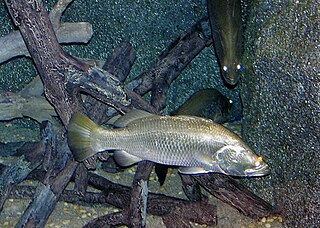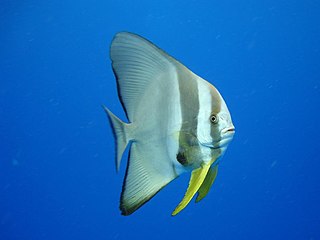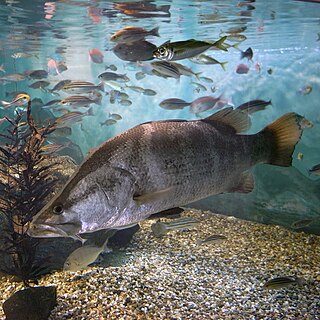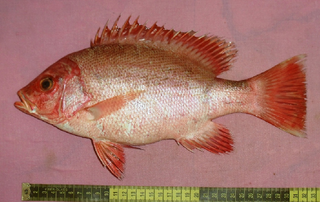Sea bass is a common name for a variety of different species of marine fish. Many fish species of various families have been called sea bass.

Sebastes norvegicus, the rose fish, rock fish, ocean perch, Atlantic redfish, Norway haddock, golden redfish, pinkbelly rosefish, Norway Seaperch, Scottish Seaperch or bergylt, is a species of marine ray-finned fish belonging to the subfamily Sebastinae, the rockfishes, part of the family Scorpaenidae. It is found in the North Atlantic Ocean. It is a large, slow-growing, late-maturing fish and the subject of a fishery.

The barramundi, Asian sea bass, or giant sea perch is a species of catadromous fish in the family Latidae of the order Perciformes. The species is widely distributed in the Indo-West Pacific, spanning the waters of the Middle East, South Asia, Southeast Asia, East Asia, and Oceania.

The Gonostomatidae are a family of mesopelagic marine fish, commonly named bristlemouths, lightfishes, or anglemouths. It is a relatively small family, containing only eight known genera and 32 species. However, bristlemouths make up for their lack of diversity with relative abundance, numbering in the hundreds of trillions to quadrillions. The genus Cyclothone is thought to be one of the most abundant vertebrate genera in the world.

Lates is a genus of freshwater and euryhaline lates perches belonging to the family Latidae. The generic name is also used as a common name, lates, for many of the species.
The spikey bass is a species of ray-finned fish in the family Latidae, the lates perches. It is endemic to coastal waters off Western Australia, where it inhabits areas with soft substrates. It is the only species in the monotypic genus Hypopterus.

Demersal fish, also known as groundfish, live and feed on or near the bottom of seas or lakes. They occupy the sea floors and lake beds, which usually consist of mud, sand, gravel or rocks. In coastal waters, they are found on or near the continental shelf, and in deep waters, they are found on or near the continental slope or along the continental rise. They are not generally found in the deepest waters, such as abyssal depths or on the abyssal plain, but they can be found around seamounts and islands. The word demersal comes from the Latin demergere, which means to sink.

Tonguefishes are flatfish in the family Cynoglossidae. They are distinguished by the presence of a long hook on the snout overhanging the mouth, and the absence of pectoral fins. Their eyes are both on the left side of their bodies, which also lack a pelvic fin. This family has three genera with a total of more than 140 species. The largest reaches a length of 66 cm (26 in), though most species only reach half that size or less. They are found in tropical and subtropical oceans, mainly in shallow waters and estuaries, though some species are found in deep sea floors, and even a few in rivers.

Euleptorhamphus is a genus of halfbeaks in the order Beloniformes.

Platax is a genus of Indo-Pacific, reef-associated fish belonging to the family Ephippidae. There are currently five known extant species generally accepted to belong to the genus. They are one of the fish taxa commonly known as "batfish".

The Japanese lates, also known as the akame or Japanese barramundi, is a species of fish found in Japan. A bottom-dweller restricted to estuarine habitats and large rivers in the Pacific coastal western parts of the country, it is threatened by habitat destruction. As it is similar to the related barramundi, it was classified as the same species until 1984.

The blackthroat seaperch, also known as the rosy seabass, is a species of fish in the family Acropomatidae, the temperate ocean-basses or lanternbellies. It is the only species in the monotypic genus Doederleinia. It is native to the eastern Indian Ocean and the western Pacific Ocean from Japan to Australia. In Japan it is known as nodoguro or akamutsu.

Lutjanus erythropterus, the crimson snapper, crimson seaperch, high-brow sea-perch, Longman's sea perch, red bream, saddle-tailed perch, small-mouth nannygai or smallmouth sea perch is a species of marine ray-finned fish, a snapper belonging to the family Lutjanidae. It is found in the Pacific and Indian Oceans.

Lutjanus vitta, the brownstripe red snapper, brownstripe snapper, broadband seaperch, brownstripe seaperch, one-band sea-perch, one-lined snapper or striped seaperch, is a species of marine ray-finned fish, a snapper belonging to the family Lutjanidae. It is native to the western Pacific and Indian Oceans.

Lutjanus lemniscatus, the yellowstreaked snapper, darktail snapper, darktail seaperch or maroon sea-perch is a species of marine ray-finned fish, a snapper belonging to the family Lutjanidae. It is native to the western Pacific and Indian Oceans.

Lutjanus carponotatus, the Spanish flag snapper, stripey snapper, dusky-striped sea-perch, gold-banded sea perch, gold-stripe sea-perch, striped seaperch or stripey seaperch, is a species marine ray-finned fish, a snapper belonging to the family Lutjanidae. It is native to the western Pacific and Indian Oceans, from India to northern Australia.

Sebastes ventricosus, the Japanese black seaperch or Japanese blueback seaperch, is a species of marine ray-finned fish belonging to the subfamily Sebastinae, the rockfishes, part of the family Scorpaenidae. It is found in the northwestern Pacific Ocean. In Japan this species is known as Mebaru(メバル/鮴).

Datnioides campbelli, the New Guinea tiger perch, New Guinea tigerfish or Campbell's tigerfish, is a species of ray-finned fish belonging to the family Lobotidae. This species is found in both fresh and brackish waters in rivers, swamps and tidal creeks in southern New Guinea.
Barramundi is a saltwater fish of the Indian and western Pacific oceans also called the Asian sea bass. Barramundi, meaning "large-scaled river fish", may also refer to:
















